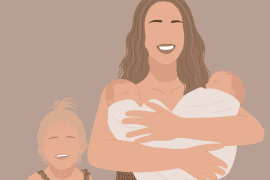3. Releasing the pelvic floor fully comes from the breath on the inhalation.
When we inhale, the diaphragm contracts and moves downward into the abdomen, opening up the rib cage, the abdominals, the back and the pelvic floor.
On the exhalation, the diaphragm moves up, and this is when the pelvic floor and deep core muscles ideally contract.
A lot of times though, when women first come to see me, they’ve been mistakenly exhaling to relax the pelvic floor. And they’ve been doing this by bearing downwards (pushing) onto the pelvic floor and outwards onto the lower belly, which can make symptoms worse.
A lot of times though, when women first come to see me, they’ve been mistakenly exhaling to relax the pelvic floor.
4. Sucking our belly buttons in prevents the pelvic floor from being able to work properly
This is a tricky one, because a lot of women see what they refer to as a ‘poochy’ lower belly, and then draw in from the belly button – sometimes all day, every day. This locks down the natural pressure system in the abdominals – preventing a proper contraction from the diaphragm, and stopping that deep transverse abdominis muscle from doing its job.
When we do this, not only does it increase lower belly distention, but it can lock down the ribcage and upper back, often resulting in neck pain and shoulder pain.
5. When our pelvic floor isn’t functioning well, we squeeze our glutes (butt muscles) to compensate
This is the most common pattern I see. If you stand up for a minute or 2, do you start clenching the muscles in your bottom, or rock from side to side? These big muscles can become really tight and sore when they are doing the work for the core all day, every day. Once they kick in to stabilise the pelvis, a lot of women find it hard to contract the pelvic floor without using their glutes – even though our glutes aren’t part of a good pelvic floor contraction.
Kristy Ahale is an Exercise Scientist who has worked in the areas of strength, rehabilitation and women’s health for over 15 years. Her mission is to change the way women exercise after children after seeing so many experience issues like prolapse, leaking and back pain, even years after having kids. She created The Postpartum Method as a 3 level progression through healing exercise to strength and fitness in order to teach women exactly how their bodies work, and how to therefore make the progress they want without doing any damage. You can join their communities on Facebook and Instagram.










